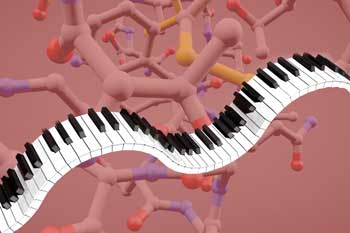| Sep 12, 2019 | |
Polymer 'music' for molecular 'ears'(Nanowerk News) Polymers are large molecules, formed by chains of monomers (smaller molecules) that bind together. Some of these polymers have a helix-shaped structure, which make that they are known as helical polymers; When the same chain is formed from two different types of monomers, the resulting polymer is called a copolymer. |
|
| Helical polymers constitute the main research line of CiQUS NanoBioMol group, led by scientists Félix Freire and Emilio Quiñoá. Their work in recent years has allowed to advance in the development of new intelligent materials capable of reacting in different environments, including biological, from external stimuli -light, heat, etc. | |
| In their most recent contribution, researchers describe in Angewandte Chemie International Edition ("Chiral Conflict as a Method to Create Stimuli-Responsive Materials Based on Dynamic Helical Polymers") the design and synthesis of a new multisensor material based on helical copolymers, capable of successfully detecting and identifying metal cations in solution (i.e., positively charged atoms), as well as with various valences (different number of electrons). | |
 |
|
| The researchers compare the interactions of the new sensor with the performance of a piano (Image: Pixabay / CiQUS) | |
| The most relevant contribution of this research lies in the fact that the capabilities of the new sensor have been generated through the so-called Chiral Conflict, an effect barely described earlier in polymer chemistry; in fact, the effect finds its first practical application in this work. . | |
| CiQUS scientists use a musical metaphor to explain the essence of the new sensor: "Let us think of this polymer as a molecular musical keyboard," says Felix Freire. "The monomers that form it would be the equivalent of the two types of keys available on the piano, but according to who plays them, and in which way, the harmonic richness will be different". | |
| For Emilio Quiñoá, the key lies in the stimuli: "a piano offers an answer after each specific action of the performer, but depending on the resulting sound it is possible to identify the hands that played it. Something similar occurs with our sensor, which obtains different and individualized chiro-optical responses through the identification of our external stimuli". |
| Source: Centro Singular de Investigación en Química Biológica y Materiales Moleculares (CIQUS) | |
|
Subscribe to a free copy of one of our daily Nanowerk Newsletter Email Digests with a compilation of all of the day's news. |
